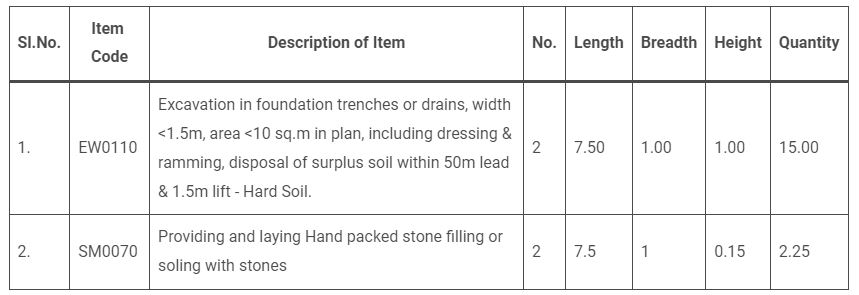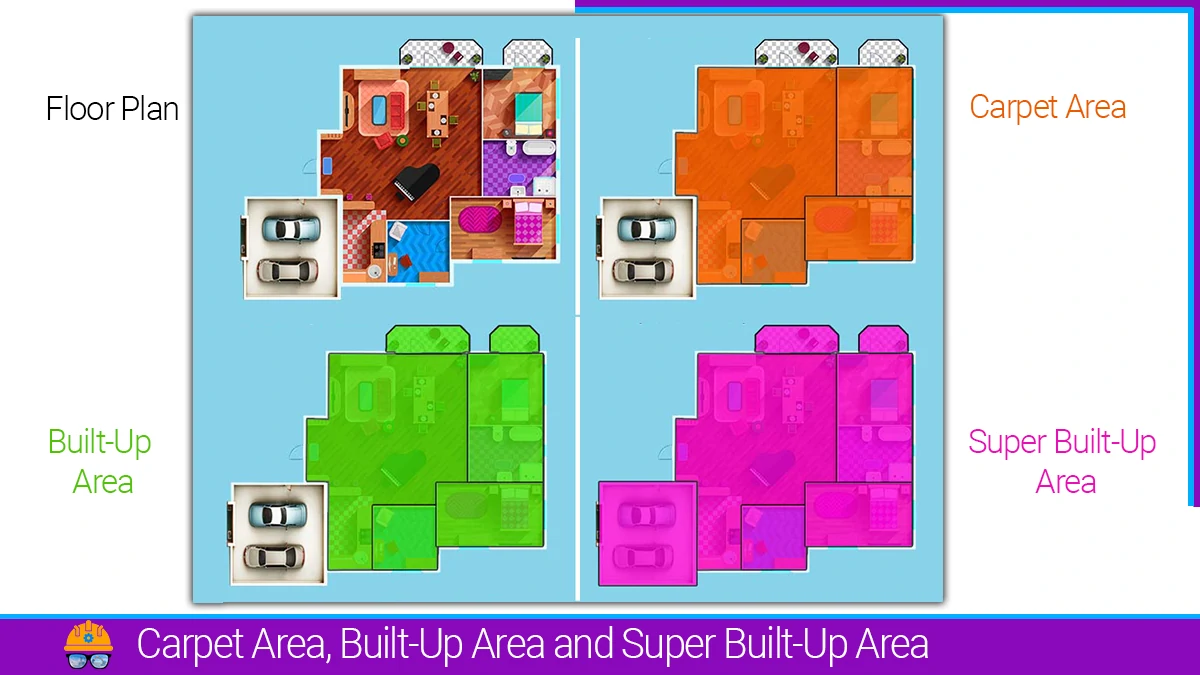In a construction project, an estimate refers to the process of predicting or approximating the costs, quantities, and durations associated with a construction project. It involves evaluating the scope of work, materials required, labour expenses, equipment costs, and other factors to determine the overall project cost.
Estimating is typically performed during the early stages of a construction project, such as during the bidding or planning phase. The purpose of an estimate is to provide a rough assessment of the project’s financial requirements or expected expenditure to complete the project, allowing contractors, owners, and stakeholders to make informed decisions about budgeting, financing, and feasibility.
Types of Estimates:
Preparing construction estimates has several approaches in which comprehensive analysis of each individual item, considering all relevant details, or through a rough approximation that doesn’t go much into the details of the work. Thus, the following five types of estimates are identified.
- Preliminary or Approximate estimate.
- Detailed estimate.
- Maintenance or Repairs estimate.
- Revised estimate
- Supplementary estimate.
Preliminary Estimate:
The preliminary estimate is commonly referred to as an approximate estimate or budget estimate. This estimate is prepared to determine the financial aspect and policy considerations, as well as to provide an understanding of the proposed project’s cost to the relevant sanctioning authority. It should clearly demonstrate the necessity of the proposal and outline how the cost has been determined.
The calculations for preliminary estimates can be conducted using the data, obtained from a similar construction project that has recently been completed in the nearby area by the department.
For instance, to calculate an approximate estimate for a hospital, the cost per bed is derived from a recently completed hospital and then multiplied by the number of beds required for the proposed project. Similarly, for a house, the cost per square meter of plinth area is calculated and multiplied by the projected covered area. It is important to ensure that the specifications remain consistent. In the case of a road, the cost per kilometre is considered, and the width of the road also plays a role in the estimation process.
The following documents should be attached to it.
- Detailed report
- Site plan of the proposal
- It should also clearly mention the acquisition of land, Provision of electric and water supply etc.
A preliminary cost estimate can be conducted on a similar building recently constructed as:
- Rough Cost Estimate Based On Plinth Area
- Rough Cost Estimate Based On Cubic Contents.
Also, read: 2 Methods of Estimate For Buildings.
Rough Cost Estimate Based On Plinth Area:
The plinth area of a building means Length × Breadth (roofed portion only) excluding plinth offsets. The estimates are prepared on the basis of plinth areas of the various buildings proposed to be constructed. The rates are being arrived at by dividing the total cost of construction by its plinth area.
For example: if the total cost of a building is 3.5 lac and its plinth area is 50 sq.m., then the plinth area rate is 7000/- per sq. m. Using this rate as the basis of the next construction, approximate or rough cost of the proposal can be arrived at by multiplying the plinth area of the proposed building with this plinth area rate.
The following documents are attached with the estimate.
- Line plan of the building with brief specifications.
- Cost of various services added i.e. electric and water supply etc.
- The north line should be shown clearly on the line plan.
Rough Cost Estimate Based On Cubic Contents:
The cubic contents of a building mean plinth area × height of the building. The height is taken from the top of the floor level to the top of the roof.
The cubic contents of the proposed building are multiplied with cubic rates arrived at for the similar construction i.e. total cost of construction divided by cubic contents = cost per cubic metre.
Also, read: What Is Rate Analysis In Construction? | Analysis Of Rate
Detailed Estimate:
After getting Administrative approval on the rough cost estimate, detailed estimates are prepared. In this, the estimate is divided into sub-heads and quantities of various items are calculated individually.
At the end of the detailed quantities, an abstract of cost giving quantities of each item and the rate of every item according to the sanctioned schedule of rates shall be attached. In case of non-schedule rates i.e. rates which are not given in the sanctioned schedule of rates, proper analysis of rates shall be attached. If however the work proposed to be constructed is located in a remote place, the provision for the carriage of the material shall be added in the estimate to avoid any excess over the administratively approved estimate later on.
Detailed Specifications and report should also be attached with the estimate. Technical sanction is given on a detailed estimate. The detailed estimate shall also provide for the cost of the approach road, water supply, electric installations acquisition of land etc, so as to call it a comprehensive estimate.
The preparation of a detailed estimate consists of working out quantities of various items of work and then determining the cost of each item. This is prepared in two stages.
- Details of measurements and calculation of quantities: The complete work is divided into various items of work such as earthwork, concreting, brickwork, R.C.C., and Plastering etc., The details of measurements are taken from drawings and entered in respective columns of prescribed proforma. the quantities are calculated by multiplying the values that are in the numbers column by the Depth/Height column as shown below:

- Abstract of Estimated Cost: The cost of each item of work is worked out from the quantities that are already computed in the detailed measurement form at a workable rate. However, the total cost is worked out in the prescribed form, which is known as an abstract of the estimated form. 4%of the estimated Cost is allowed for Petty Supervision, contingencies and Unforeseen items.

Maintenance or Repair Estimate:
Maintenance work for newly constructed structures is a periodic cycle to maintain the integrity and aesthetic of the structure. Thus, there should be a certain amount of cost allocated to carry out the repair works. This maintenance cost is derived by carrying either an annual repair estimate or a special repair estimate depending upon the integrity of the structure.
Annual Repair Estimate:
In order to keep Buildings and Roads in perfect condition, annual repairs should be carried out as follows:−
- In Case of a Building:– White-washing, oiling and painting of doors and windows, cement plaster repairs (inside & outside), repairs of floors etc. In no case, this annual repair amount should increase by more than 1.5% to 2% of the capital cost of the building.
- In Case of a Road:–Filling patches, maintenance of berms etc.
Also, read: What is the Measurement Book in Civil Engineering and Construction?
Special Repair Estimate:
If the work cannot be carried out with the annual repair funds for certain reasons, resulting in a genuine increase in cost, then a special repair estimate must be prepared.
The reason for the increase may be:−
- In Case of a Building:–opening of new doors, change of floors, replastering walls etc.
- In Case of a Road:–If the whole surface is full of corrugation & patches, then the total surface is to be sacrificed. The old metal is taken out, reconsolidation by adding more metal is done and the top surface is repainted.
Revised Estimate:
In cases where the sanctioned estimate exceeds 5%, whether due to insufficient rates or other factors, a Revised Estimate is prepared. This revised estimate takes into account the increased cost and provides a detailed analysis of the reasons for the cost escalation for each item. A comparative statement outlining the cost increase is attached to the last page of the estimate, providing transparency and justification for the revised costs.
Supplementary Estimate:
When additional works are deemed necessary during the course of a project to complement the original scope, a new detailed estimate is prepared, known as a supplementary estimate. This estimate provides a comprehensive breakdown of the costs associated with both the original sanctioned estimate and the additional works. The abstract of cost should clearly indicate the amount of the original sanctioned estimate and the supplementary amount for which additional sanction is required. As an illustration, consider the construction of a generator room in the proposed office.
Also, read: Carpet Area | Built-Up Area | Super Built-Up Area
FAQs:
Q: What is the purpose of estimation?
Ans: There are several purposes for estimation and some of them are:
1. To know the expected expenditure or cost to complete the project.
2. For acquiring technical, financial and administrative sanctions for the construction project.
3. Calculate the required quantities of materials and labour for the construction project.
4. For preparing bid documents
4. To allot a fund for conducting the maintenance work.
Q: Why do we need estimation?
Ans: We need an estimation to know the expected cost to complete the project or to conduct the maintenance work for roads, bridges or buildings.
Q: What is a detailed estimate?
Ans: Detailed estimate is the estimate that shows the detailed breakdown of the work with its detailed quantities and corresponding cost abstract. The detailed estimate is usually prepared by studying complete drawing sets that include architecture, structure, plumbing, electrical drawings, etc. in the case of building construction projects.
References:
- Dutta, B.N. (2011). Estimating and Costing in Civil Engineering (26th Revision). UBS Publisher’s Distributors Pvt. Ltd.
- Chakraborti, M. (Chartered Engineer). (1963). Estimating, Costing and Specification in Civil Engineering (1st ed.). 21B, Bhabananda Road, Calcutta-26
- Anupoju, S. (2020, February 9). 8 Types of cost estimates in construction. The Constructor. https://theconstructor.org/construction/top-eight-cost-estimates-construction/841/
![]()







